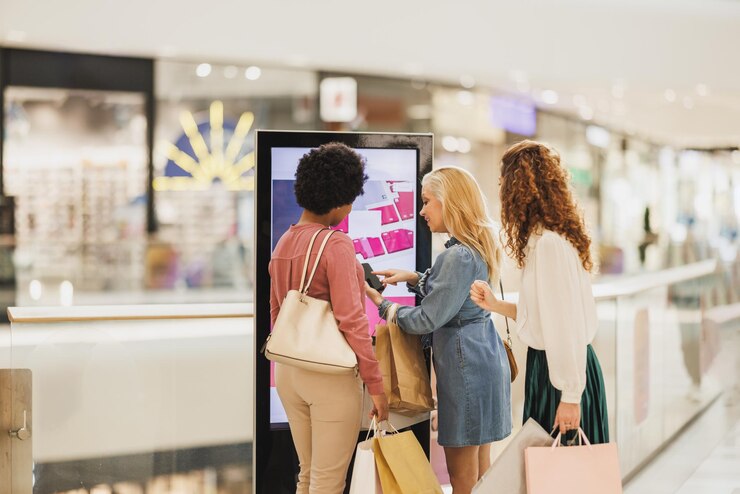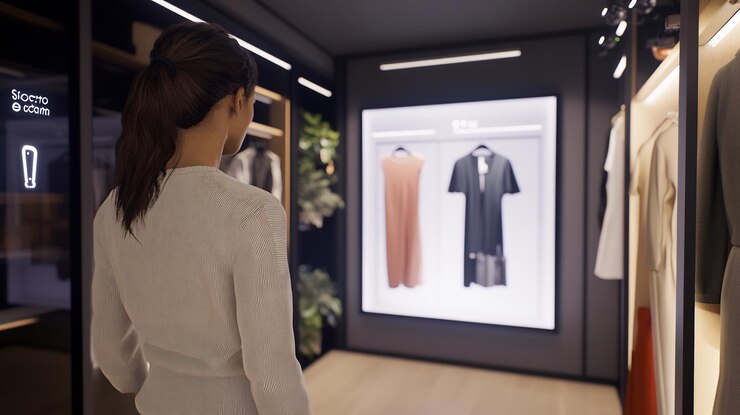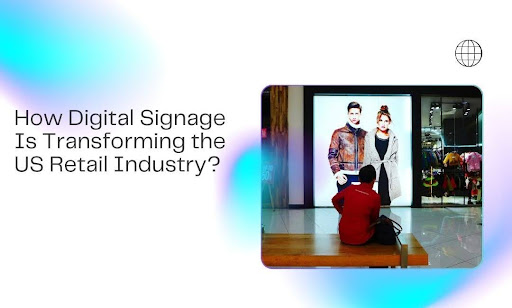What if foot traffic wasn’t the real problem? Most retailers pour money into ads, redesign their storefronts, and wait for the needle to move. But the moment someone steps inside, the experience falls flat. Screens are static. Signage is outdated. Offers are stale before they go up. And customers? They walk in, look around, then scroll back to their phones.
Here’s the truth: the problem isn’t the product—it’s the presentation. Digital signage has changed the entire retail script. And it’s working.
Retailers using dynamic signage see up to 30% higher purchase intent and five times more attention than traditional print displays. We’ve seen CrownTV clients cut display changeover time from days to minutes—all from one dashboard.
This article breaks down how the shift is happening and how you can put it to use:
- How in-store behavior is being reshaped by screens
- The role of live content updates, seasonal automation, and dynamic pricing
- Why static signage is costing more than you think
- Which retailers are getting it right—and what they’re doing differently
- Where CrownTV fits into this shift with plug-and-play tech, app integrations, and national support
You don’t need a massive rollout to get results. You need a system that gets the message across faster. Let’s break the system down.
Screens That Guide, Influence, and Close the Sale

Walk into any U.S. retail store today, and you’ll notice something different.
Shoppers aren’t aimlessly browsing like they used to. They’re moving with purpose—eyes scanning digital displays, responding to prompts, reacting to content that shifts instantly. Digital signage isn’t background noise anymore. It’s the conversation starter, the silent salesperson, and in many cases, the final push to checkout.
Here’s what the numbers are showing: According to a Nielsen study, digital signage captures 400% more views than static displays, with nearly 60% of shoppers stating that it influences their purchasing decisions. That’s not a bump—it’s a behavioral shift. So what’s changing?
- People follow visual cues faster than they ask for help: Shoppers are turning toward screens before they speak to staff. Why? Because screens offer something most employees can’t—instant answers and visual clarity. A sale price, a product comparison, a location within the store—screens guide them without friction. In these retail environments, fast access to content leads the way.
- Product discovery starts on digital displays—not shelves: Traditional aisle browsing is fading. Retailers are using digital signage to put specific products in front of shoppers before they ever reach the aisle. Think motion-triggered promos. Think high-margin bundles. Think recommendations based on time of day, weather, or stock levels. These digital signage plays give brands tighter control over high-interest products.
- Dwell time is up—but so is purchase intent: The longer someone stays, the more likely they are to buy—but only if the environment keeps their attention. Digital screens make that happen. They pull interest toward promotions, educational content, and urgency-driven CTAs that keep people engaged while they wait in line or move through the store. It enhances the in-store experience by aligning visual flow with decision points. In fact, a study found that stores using digital signage experienced an average 32.8% increase in dwell time, with most of that attention directed toward promoted products.
- Impulse behavior isn’t random—it’s steered: Screens don’t just reflect behavior—they reshape it. In checkout zones, endcaps, or near trial-size items, well-placed content pushes shoppers to act on impulse more often. Seasonal triggers, time-sensitive offers, or limited stock messages give people a reason to grab one more item. These interactive customer experiences give retailers a tactical edge without overwhelming staff.
- Consumer expectations are different now: Shoppers aren’t comparing a store to the one next door—they’re comparing it to their phone. Fast, visual, and personalized. This shift pushes leading retailers to build smarter systems that respond in the moment, not in the next campaign cycle.
- Enabling retailers to keep people engaged means staying flexible: To retain customers, messaging has to stay relevant. Digital signage makes that possible without printing delays or slow approvals. What used to take days now happens in minutes.
- Traditional advertising no longer holds attention: Print signs, static posters, and generic messaging fall flat. The digital signage journey replaces them with dynamic, responsive systems that pull more value from every square foot of store space.
Behavior in stores is changing—and it’s not by accident. It’s being shaped by what people see, when they see it, and how easy it is to act on it.
How Retailers Push Content, Pricing, and Timing Into Place
Static signs lock you into decisions. They age fast. They force early approvals. And once they’re up, you’re stuck with them.
Digital signage clears that problem out of the way. Retailers now move content across stores with a few clicks—whether it’s a daily deal, a flash sale, or a time-sensitive promotion tied to weather, location, or foot traffic patterns.
What drives this speed?
- Live content lets retailers move faster than their competition: Promotions no longer run on fixed schedules. Retailers can push an offer to 300 stores in under five minutes. That means you don’t need to prepare for Black Friday weeks ahead. You can move pricing and messages throughout the day based on stock, demand, or store traffic. With live updates, timing aligns with the floor, not the calendar.
- Seasonal automation takes the pressure off your team: Manual scheduling creates room for errors, missed deadlines, and inconsistent messaging. That’s why more teams now build automation rules into their signage strategy. Seasonal content rolls out automatically based on preset triggers—holidays, local events, or specific weeks. You front-load the setup, then let the system push the content out when it counts. It also makes testing easier. Want to see how a different price or product mix performs in Texas versus California? You can roll it out to one region, collect the data, and adjust without touching a printer or calling a manager.
- Dynamic pricing brings control back to the floor: Price tags shouldn’t dictate what the screen shows. Retailers now flip the model, where screen content drives pricing decisions, not the other way around. That means pricing can shift based on volume, margins, or competitor moves. Let’s say inventory builds up on a slow-moving product. The price drops automatically, the screen reflects it immediately, and the promotion starts pulling buyers without delay.
Retailers who update content and pricing on the move not only gain speed. They gain control. And that changes how they respond to pressure, shift with seasons, and push profit where they need it most.
The Hidden Costs of Keeping Static Signage
Printing signs looks cheap—until you break the numbers down. What seems like a simple in-store update can drain more time, money, and labor than most retail teams account for. The real cost of static signage doesn’t show up on the invoice. It shows up in delays, waste, and missed sales.
Here’s where the money slips out.
- Design and Approval Lag: Every sign goes through review cycles. Designers create mockups. Managers send edits. Corporate approves the final version. That slows things down and creates backlogs, especially during peak sales periods. Labor adds up, even before printing starts. Average time per sign: 2 to 4 hours. Estimated cost per design round: $100–$200 in salaried labor.
- Printing and Distribution: Print vendors rarely turn signs around overnight without charging rush fees. Then you’re paying to ship signage to dozens—or hundreds—of locations. One change in pricing or product copy, and you’re forced to repeat the cycle. Average cost per store update:
- $30–$50 per set of signs
- $15–$25 in packaging and shipping
- Multiply by store count
Total for 100 stores: $4,500–$7,500 per rollout
- Store-Level Setup Time: Once the signs arrive, staff need to unpack, sort, and install each one. Inconsistent placement leads to uneven results. Some locations skip installs. Others miss the deadline. None of it scales cleanly.
- Estimated install time per store: 1–2 hours
- Labor cost per install: $20–$40
- For 100 stores: $2,000–$4,000 per cycle
- Waste and Disposal: Old signage goes into the trash. Some teams try to recycle, others store leftovers that never get reused. There’s no long-term value in printed collateral. Once it’s outdated, it’s a sunk cost. Average loss per campaign cycle: $1,000–$3,000 in unused material
- Missed Timing, Missed Revenue: Even a two-day delay in launching a promotion cuts into the margin. Missed signage means missed signals to shoppers. The cost isn’t always easy to measure, but it shows up in lower conversion rates and excess stock that needs to be discounted later.
Static signage pulls money out quietly. It burns hours, eats budgets, and slows teams down without offering flexibility in return.
Retailers Who Are Moving the Needle With Smart Screens

The ones leading the shift aren’t only replacing posters with screens. They’re building systems that adapt, react, and feed data back into smarter decisions. Retailers getting digital signage right are doing four key things—and they’re not waiting around to catch up.
They feed AI into their displays
Top-performing retail brands are integrating AI to fine-tune what appears on screen, when it plays, and where it performs best. These systems go beyond preset schedules.
AI engines analyze store-level variables like:
- Entry and exit flow
- Average dwell time by zone
- Real-time SKU performance from POS
- Local weather and event calendars
- Time-of-day foot traffic data
The AI model then triggers content rotations based on rules, without requiring human input. For instance, if umbrella sales spike in one store during rain, the same AI logic pushes umbrella promos to nearby locations before the rain hits.
Retailers aren’t setting fixed loops anymore. They’re training models to target content automatically, using behavioral, environmental, and transactional data to drive screen decisions.
They build feedback loops with data
Retailers leading with digital signage are not broadcasting—they’re collecting. Every impression, interaction, and conversion is logged. These systems measure granular performance across multiple variables, including:
- Screen-level engagement metrics (dwell time, view-through rate, interaction)
- Message performance by region, time, and store format
- Lift in sales tied to specific content exposures
- Drop-off points in high-traffic areas
Data pipelines flow from edge devices (signage players) into cloud dashboards, where marketing and ops teams analyze real-world impact by message. If one promotion underperforms in urban stores but excels in suburban formats, the system adapts the rollout map in the next cycle.
Retailers are no longer guessing. They’re closing the loop between creative, analytics, and revenue.
They make the experience interactive
Interactive signage is no longer a luxury—it’s becoming a requirement in high-engagement zones. Retailers are integrating:
- Touch-enabled displays for product browsing, style matching, or size availability
- NFC-triggered content that reacts to smartphones or loyalty cards
- Sensor-based motion tracking that adapts displays based on proximity or direction of movement
- Voice-recognition commands for accessibility and faster customer support
These technologies reduce pressure on floor staff, accelerate product discovery, and increase the precision of promotional messaging. When a customer asks a kiosk for “leather boots under $100,” the screen updates in seconds and shows SKUs tied to local inventory.
It’s not a gimmick. It’s a controlled interface that reduces friction and increases basket size.
They go green without cutting impact
Modern signage hardware is being chosen for energy profile, not just display quality. Forward-thinking retailers are rolling out:
- LED-backlit LCD panels with auto-brightness sensors that adjust based on ambient light
- Low-power media players using ARM-based processors with passive cooling (no fan noise, minimal heat output)
- Smart energy management systems that schedule screen times after hours or reduce brightness in low-traffic windows
- Modular designs that allow component replacement without full unit swaps
This shift isn’t branding—it’s cost containment. Energy-efficient interactive digital displays reduce annual per-store electricity costs and align with internal ESG goals. Some retailers are pairing this with solar-fed battery backups for outdoor signage to reduce strain on grid power entirely.
The impact stays high. The footprint stays low.
They test what’s next, before it hits the mainstream
Retailers who lead in digital signage innovation are already running pilots with next-gen technologies across flagship stores or innovation labs. These tests include:
- Holographic displays that present products in 3D without glasses, enabling touchless exploration
- Facial detection sensors that track aggregate age group, dwell time, and attention without storing personal data
- Dynamic shelving integrations, where weight sensors on shelves trigger screen content changes when product levels shift
- Spatial computing and AR overlays, where customers scan interactive displays with their phones to view content mapped onto physical space
- Edge computing platforms that process signage logic locally to reduce latency and remove reliance on cloud uptime
Each test isn’t run for novelty. It’s a measurable deployment aimed at improving conversion, reducing staff dependency, or unlocking new forms of engagement. Retailers that win are not waiting for trends to stabilize. They’re putting controlled pilots in place, then scaling what sticks.
These strategies aren’t theoretical—they’re in the field, working. The gap between early adopters and traditional retailers keeps growing, not because of screen count, but because of how those screens are programmed, measured, and improved.
How CrownTV Builds Digital Signage That Performs on the Floor
Retailers pushing forward need screens that do more than display—they need systems that install fast, update on demand, integrate with their tech stack, and scale across locations without slowing teams down. That’s where CrownTV steps in.
Built for execution, CrownTV’s retail digital signage solutions cover the entire lifecycle—hardware, software, content delivery, and national deployment. Every component is engineered to remove friction and speed up output without compromising on control.
Plug-and-play hardware that gets to work fast
CrownTV’s interactive digital signage player is a compact, high-performance unit that’s built for reliable, always-on operation in any retail setting. There’s no overbuild—only what’s needed to run rich media content without buffering or delay.
- Installs in minutes
- Handles high definition screens and animations with zero stutter
- Ships pre-configured to reduce tech setup at the store level
- Supports passive cooling and long-term uptime
Devices can be mounted behind any commercial display and managed remotely, so rollout doesn’t block store ops or require IT support on site. It works across retail spaces of every size—from kiosks to multi-floor anchors.
Centralized software that works across the chain
At the core is a centralized content management system known as the dashboard that gives marketing and operations teams full control over:
- Content scheduling
- Region-specific rollouts
- Campaign sequencing
- Display grouping by store format, time zone, or department
- Automation rules for seasonal promotions or inventory-based triggers
Every update pushes out from the cloud. Teams build once, then deploy everywhere. No need for spreadsheets, asset folders, or local USB updates. This digital signage software also supports fallback playlists to keep in-store digital signage running even in low-bandwidth zones.
App integrations that extend functionality, not complexity
CrownTV’s ecosystem includes hundreds of content management tools, available out of the box. These extend the signage system into:
- Inventory systems
- Point-of-sale data feeds
- Social media aggregators
- Queue management platforms
- QR-based customer engagement tools
Each integration runs natively inside the signage dashboard, which means no third-party code, no manual sync, and no hidden maintenance. Retailers can launch interactive content, loyalty prompts, or local store events using plug-ins built for scale.
Installation support and national reach
CrownTV offers white-glove installation with screen sourcing, placement strategy, and physical deployment managed by a national team. That includes:
- Indoor and outdoor screen mounting
- Kiosk setup
- Power and connectivity routing
- Pre-launch testing
- Multi-location coordination
Support doesn’t stop post-install. Teams gain access to ongoing project management for complex rollouts or system upgrades, along with CrownTV’s support engineers who resolve issues directly—no ticket queues or outsourced service desks.
CrownTV’s solution isn’t just a trend. It’s structured to get digital signs up, keep them running, and let your team scale without manual lift. It fits into the modern retail sector, supports high-performance campaigns, and adapts to brick-and-mortar retailers who need smarter content delivery across their network. Whether you’re running a clothing store, managing dozens of franchises, or scaling interactive kiosks nationwide, CrownTV helps boost operational efficiency and shape the customer journey with personalized content, dynamic displays, and interactive features that engage customers.
CrownTV also supports eco-friendly business practices, giving retailers a clear path to sustainable signage without losing performance. As digital signage continues to shape the retail experience, CrownTV is built for teams committed to implementing digital signage systems that work, not systems that need to be managed full-time.
Let Digital Signage Do the Heavy Lifting in the US Retail
Retail isn’t standing still, and signage shouldn’t either. Static prints, manual rollouts, and slow updates can’t keep up with how shoppers move, respond, and buy today. Digital signage is no longer an upgrade—it’s a requirement for retail teams that want to control costs, push content faster, and shape store behavior in ways that convert.
Retailers leading this shift aren’t relying on more people. They’re leaning on smarter systems. The ones that plug in easily, respond to data, and flex with the floor. That’s where high-performance signage—powered by tech like AI, automation, and interactivity—starts to carry its weight.
Here’s what we covered:
- What digital signage is doing to reshape in-store behavior across the U.S.
- How retailers use live content, automation, and flexible pricing to move faster
- Where static signage drains time, money, and opportunity
- What modern retailers are deploying—from AI and analytics to energy-efficient screens
- How CrownTV builds plug-and-play solutions that keep teams focused and stores running
Whether you’re overseeing 20 stores or 2,000, CrownTV is built to plug into your stack, take pressure off your team, and deliver consistent performance—from install to execution.

